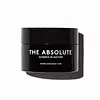What's inside
What's inside
 Key Ingredients
Key Ingredients

 Benefits
Benefits

 Concerns
Concerns

 Ingredients Side-by-side
Ingredients Side-by-side

Water
Skin ConditioningGlycerin
HumectantButylene Glycol
HumectantPanthenol
Skin ConditioningPentylene Glycol
Skin ConditioningPhenoxyethanol
PreservativeChlorphenesin
AntimicrobialAcrylates/C10-30 Alkyl Acrylate Crosspolymer
Emulsion StabilisingTrehalose
HumectantXylitylglucoside
HumectantSodium Hyaluronate
HumectantAnhydroxylitol
HumectantDisodium EDTA
Sodium Hydroxide
BufferingYeast Extract
Skin ConditioningXylitol
HumectantHydrolyzed Hyaluronic Acid
HumectantCarrageenan
Agar
MaskingPotassium Chloride
Xanthan Gum
EmulsifyingUltramarines
Titanium Dioxide
Cosmetic ColorantWater, Glycerin, Butylene Glycol, Panthenol, Pentylene Glycol, Phenoxyethanol, Chlorphenesin, Acrylates/C10-30 Alkyl Acrylate Crosspolymer, Trehalose, Xylitylglucoside, Sodium Hyaluronate, Anhydroxylitol, Disodium EDTA, Sodium Hydroxide, Yeast Extract, Xylitol, Hydrolyzed Hyaluronic Acid, Carrageenan, Agar, Potassium Chloride, Xanthan Gum, Ultramarines, Titanium Dioxide
Water
Skin ConditioningCitrus Aurantium Dulcis Fruit Water
MaskingGlycerin
HumectantPropanediol
SolventCetearyl Olivate
Silica
AbrasiveCetyl Alcohol
EmollientCoco-Caprylate/Caprate
EmollientButyrospermum Parkii Butter
Skin ConditioningSorbitan Olivate
EmulsifyingOpuntia Ficus-Indica Seed Oil
EmollientCocos Nucifera Oil
MaskingRosa Canina Fruit Oil
EmollientLycium Barbarum Fruit Extract
AstringentKappaphycus Alvarezii Extract
Skin ConditioningAvena Sativa Kernel Extract
AbrasiveCaesalpinia Spinosa Fruit Extract
Skin ProtectingRosa Damascena Extract
MaskingSodium Hyaluronate
HumectantBenzyl Alcohol
PerfumingCyclodextrin
AbsorbentTitanium Dioxide
Cosmetic ColorantParfum
MaskingAscorbic Acid
AntioxidantLaminaria Japonica Extract
Skin ProtectingDehydroacetic Acid
PreservativeTocopherol
AntioxidantBenzoic Acid
MaskingPotassium Hydroxide
BufferingSorbic Acid
PreservativeCellulose Gum
Emulsion StabilisingBiosaccharide Gum-1
HumectantLinalool
PerfumingSodium Benzoate
MaskingSodium Levulinate
Skin ConditioningLimonene
PerfumingPotassium Sorbate
PreservativeGlyceryl Caprylate
EmollientBeta-Sitosterol
Emulsion StabilisingGlycine Soja Oil
EmollientChondrus Crispus Powder
AbrasiveSqualene
EmollientGeraniol
PerfumingCitral
PerfumingSodium Anisate
AntimicrobialGlucose
HumectantCeratonia Siliqua Gum
EmollientCitric Acid
BufferingWater, Citrus Aurantium Dulcis Fruit Water, Glycerin, Propanediol, Cetearyl Olivate, Silica, Cetyl Alcohol, Coco-Caprylate/Caprate, Butyrospermum Parkii Butter, Sorbitan Olivate, Opuntia Ficus-Indica Seed Oil, Cocos Nucifera Oil, Rosa Canina Fruit Oil, Lycium Barbarum Fruit Extract, Kappaphycus Alvarezii Extract, Avena Sativa Kernel Extract, Caesalpinia Spinosa Fruit Extract, Rosa Damascena Extract, Sodium Hyaluronate, Benzyl Alcohol, Cyclodextrin, Titanium Dioxide, Parfum, Ascorbic Acid, Laminaria Japonica Extract, Dehydroacetic Acid, Tocopherol, Benzoic Acid, Potassium Hydroxide, Sorbic Acid, Cellulose Gum, Biosaccharide Gum-1, Linalool, Sodium Benzoate, Sodium Levulinate, Limonene, Potassium Sorbate, Glyceryl Caprylate, Beta-Sitosterol, Glycine Soja Oil, Chondrus Crispus Powder, Squalene, Geraniol, Citral, Sodium Anisate, Glucose, Ceratonia Siliqua Gum, Citric Acid
 Reviews
Reviews

Ingredients Explained
These ingredients are found in both products.
Ingredients higher up in an ingredient list are typically present in a larger amount.
Glycerin is already naturally found in your skin. It helps moisturize and protect your skin.
A study from 2016 found glycerin to be more effective as a humectant than AHAs and hyaluronic acid.
As a humectant, it helps the skin stay hydrated by pulling moisture to your skin. The low molecular weight of glycerin allows it to pull moisture into the deeper layers of your skin.
Hydrated skin improves your skin barrier; Your skin barrier helps protect against irritants and bacteria.
Glycerin has also been found to have antimicrobial and antiviral properties. Due to these properties, glycerin is often used in wound and burn treatments.
In cosmetics, glycerin is usually derived from plants such as soybean or palm. However, it can also be sourced from animals, such as tallow or animal fat.
This ingredient is organic, colorless, odorless, and non-toxic.
Glycerin is the name for this ingredient in American English. British English uses Glycerol/Glycerine.
Learn more about GlycerinSodium Hyaluronate is hyaluronic acid's salt form. It is commonly derived from the sodium salt of hyaluronic acid.
Like hyaluronic acid, it is great at holding water and acts as a humectant. This makes it a great skin hydrating ingredient.
Sodium Hyaluronate is naturally occurring in our bodies and is mostly found in eye fluid and joints.
These are some other common types of Hyaluronic Acid:
Learn more about Sodium HyaluronateTitanium dioxide is a mineral UV filter widely used in sunscreens and cosmetics.
It is one of only two UV filters officially classified as “mineral” by regulatory agencies, the other being zinc oxide.
Titanium dioxide provides broad-spectrum protection mostly in the UVB and UVAII range, with some protection in the UVAI range.
While its UVA protection isn’t as strong as zinc oxide’s, the difference is minor.
A common myth is that mineral UV filters reflect UV light. However, modern research shows titanium dioxide absorbs UV radiation like chemical filters (~95% absorption & 5% reflection).
Thanks to its non-irritating nature, titanium dioxide is suitable for sensitive, acne-prone, or redness-prone skin. It is unlikely to cause "eye sting" like other sunscreen ingredients.
A major drawback of this ingredient is its white cast and thick texture. This is why mineral sunscreens often leave a white cast and are less cosmetically elegant than chemical/hybrid sunscreens.
To improve white cast and spreadability, micronized or nano-sized titanium dioxide is often used.
There are ongoing concerns surrounding nano-titanium oxide's impact on marine ecosystems.
There is no conclusive evidence that any form of titanium oxide (or any other sunscreen ingredients) will cause harm to marine ecosystems or coral reefs. The science is still developing but many consumers are keeping a close eye on this issue.
Please note, many destinations have reef-safety sunscreen rules. For instance, the U.S. Virgin Islands advises all visitors to use non-nano mineral sunscreens.
Nano mineral sunscreens once raised safety concerns about absorption into skin.
Extensive research has shown that they do not penetrate healthy or damaged skin; they remain safely on the surface and the top layer of dead skin (stratum corneum).
You'll likely find titanium dioxide bundled with alumina, silica, or dimethicone. These ingredients help make titanium dioxide highly photostable; this prevents it from interacting with other formula components under UV light.
Learn more about Titanium DioxideWater. It's the most common cosmetic ingredient of all. You'll usually see it at the top of ingredient lists, meaning that it makes up the largest part of the product.
So why is it so popular? Water most often acts as a solvent - this means that it helps dissolve other ingredients into the formulation.
You'll also recognize water as that liquid we all need to stay alive. If you see this, drink a glass of water. Stay hydrated!
Learn more about Water